Warhammer Underworlds
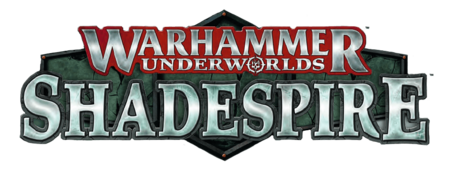
Warhammer Underworlds is a new Specialist game released by Games Workshop, situated in the shadowy city of Shadespire, where warbands battle in the streets for glory or to gain "shadeglass", a substance that can confer eternal life. It combines the easy-to-pick-up nature and deck-building from X-Wing with the setting of Age of Sigmar, an unholy fusion of the two most addictive hobbies to grace nerddom. Geedubs banked on this being a competitive tournament game, with contests already being planned even before all the factions were released, and their gamble paid off big time.
The first block, Shadespire, began with Stormcast Eternals and Khorne Bloodbound (where have I seen this before...) with all the bitz needed to play the game. In November the first wave of expansions launched, releasing skeletons and ironjawz. In February the second wave brought Fyreslayers and Skaven. April of 2018 saw the closing of the first block with Vanguard Hunters and Blood Warriors, with confirmation that the second block, Nightvault, would include the Sacrosanct Chamber, spoopy ghosts, and rules for magic; on the horizon are shroomy biggies and squiggies, grots, chaos barbarians, elf-tree-elves, dakka dwarves, and Just As Planned boys. A third block has been announced, titled Beastgrave, and looks to be bringing some variety of centaurs to the mix.
The game has a budding but dedicated competitive environment with regulated lists, banned cards and all that. As it stands, the game is fairly balanced apart from a few bottom-tier Warbands that need some real skills to make work properly. However, any good player can make a semi-competitive list work with a little elbow grease and luck. You can learn the basics here
The Setting

At the edge of the Desert of Bones in Shyish, the Realm of Death was a great city called Shadespire. The people living in it had managed to create some sort of magical mirror-like substance called "Shadeglass", which let the souls of their dead live on in mirrors put up everywhere around the city, keeping their knowledge and powers safe for future generations to use for the city’s betterment. Naturally, this didn't sit too well with Nagash, who wasn't fond of once again getting cheated out of his (imagined) tithe of death. So, to get back at those arrogant Shadespirers, he threw the entire fucking city out between the Realm of Shadow and Light in the endless void, trapping everyone inside to live out an eternity of kinda-torment until they petition themselves to him voluntarily. An unliving husk is left of Shadespire in Shyish, but the actual city, now out in the nothingness, has become impossibly vast, but fragmented and all messed up, so you never know if you can find that favorite In-And-Out Burger you love so much after you leave it.
To the surprise of no one, the destruction of Shadespire inspired legions of looters to ransack the physical ruins for Shadeglass and other riches. Unfortunately, anyone who goes just a bit too far into the city will find themselves with a one-way ticket to Shadespire for an eternity of bloodshed. With nothing better to do, the different Warbands caught in Shadespire fight it out to the bloody death for kicks - they can't die permanently anyway, as the city resurrects them within days.
The Beastgrave block shifts the setting, as a crack in reality caused by the Necroquake allows the O.G warbands to escape the city. Unfortunately, this leads them to the titular Beastgrave, a sentient and malevolent mountain that has a habit of luring in adventurers in the hopes of consuming them.
While the setting and the idea of "Warbands" might cause a few of you Mordheim players to awake from your eternal slumber, be warned that the Warbands aren't customizable at all. These guys are not your dudes, they are unique characters with names and such, so if you wanted to make your own guys, this isn't your game.
...Unless Proxy. In a friendly setting, theres nothing stopping you converting up some Savage Orcs to be Garrek's Reavers, or Magore's Fiends as some Mercenary Knights with loyal doge. Perhaps your Farstriders are actually Dorf Ironbreakers with drakefire pistols instead of stupid crossbow-pistols, or turn Spiteclaws Swarm into lizardmans. That upcoming warband with the fungus troll and cave beasties? How about an Ogre Hunter with some sabrekitties? As long as you (and your opponent) know who's what and what's who.
The Game
The game is played between two players (with a possibility for up to four players) on hex-grid boards, with the goal of gaining as many Victory Glory Points as possible before the end of the game. You gain Glory Points by either killing enemy models or by achieving Objective Cards, which you draw before the game starts. This means that you can win a game even if your entire Warband is killed off. The only thing that matters is gaining more Glory Points than the opponent.
A game is three turns of four activations each, for a total of twelve activation per person. If this sounds quick, it's because it fucking is: two players who know the rules can easily play a full game in twenty minutes or less. In tournaments, a match is almost sure to be three games in a row and tournaments are intended to be best of 3.
At the start of every game, the players roll off and the loser chooses how to place the first hex-board, with the second player placing the other board in such a way that the hexes connects properly and at least three hexes are connected. Board placement can have a drastic effect on the game, as each board side has its own starting positions and such. Then the players roll off again, the winning player choosing who is placing their models on the starting positions on their own board side first.
The players take turns doing Activations; four Activations each per Turn. An Activation lets you do one of these Actions:
- Move a model. Each model can only move once per Turn. There are tokens to indicate which models have moved.
- Attack an enemy model within reach. For each friendly model in base contact with the enemy model apart from the attacking model, the attacker hits easier (presumably as his bud holds the enemy down to the curb while your attacking models winds up his stompin’ boot). Ranged attacks go through models, but not terrain, which can make certain models a real fucking pain in the ass when they get Inspired and have Supporters on their attacks.
- Charge an enemy model, which is a Move followed by an Attack. Models cannot be activated after Charging, so use it wisely. There's also little tokens to indicate what models have charged.
- Guard with a Friendly model. This allows your model to use both Dodge and Block on the Defence die, which can help a lot if your’re a fucking human with 2 Wounds and one Dodge, which is like half the Khorne Warband. Models lose Guard if they charge in the same turn.
- Draw a Power Card. Generally don't use this; you get new Power Cards each Turn and your Activations are precious. This is nearly mandatory if you are running a SCE katophrane deck, as you will want to get your gribbly hands on to those relics.
- Discard and draw an Objective Card. Again, don't do this unless you're boned. Still, this is remarkably more useful than the other Draw option, since you can't replace your Objective Cards ever, and they win you the game if you have the proper set.
After each of your Activations you may play Power Cards which come in different flavours:
Ploys, which are free and do all sorts of interesting shit after playing them, like moving guys around or stealing the enemy's Glory Points. The other Power Card type are Upgrades, which cost Glory Points (put doesn't remove them - They still count as "Victory Points" even if used to buy an Upgrade), and are permanent upgrades to your models. Ploys make or break the game; have as many Ploys as you can (up to half of your deck) in the Power Deck and choose them very carefully. After you have played a Power Card, your opponent may do the same, then you can play one and so on, until both calls. With this, the opposing player gets to Activate.
Some cards are also Reactions which are played like magic the gathering as a counter or response to certain enemy actions, their power cards or things that have happened to your dudes.
Each model is unqiue and have an INSPIRED MOOOOODE! When the model's Inspire requirement is met, you flip the card and use the profile on the other side which usually includes new attacks and better stats. For some Warbands this is just a nice little bonus, but for others, like the Reavers, it's their entire thing and what you should build your decks around.
Deck-Building
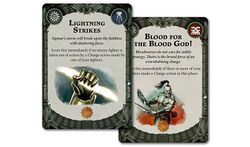
So that's pretty simple, but this is where Warbands and deck-building comes into it.
Each player has two decks; a Power Deck of 20 cards (or more) and an Objective Deck of exactly 12. A large amount of the cards available are Neutral and usable by everyone, but there's a good amount of Faction Cards that only the specific Warband can use.
The Objective Deck is the one that will win you the game, since it has the collection of cards that will award you Glory Points. Your choice of Objective Cards is crucial for your gameplan, and ideally you should have a combination of high-risk, five Glory Points cards and the easy-to-claim one Glory Point cards to tackle those situations where RNG fucked you over.
The Power Deck is the one where your Ploys (aforementioned God-cards of Awesome, dagger symbol) and Upgrades (eh, gear symbols) goes. They should help you achieve your Objectives obviously, but some are just so good that they should be in all decks if you can make them fit. Cards like Confusion (switch two models in base contact) and Sidestep (Friendly model moves one Hex) are awesome to help you get into bashing range without using Activations on Move Actions. Generally, anything that gives some additional movement fucking rocks. Only half of your deck can be Ploys. Starting with Nightvault, Spells are also added as a part of the Power Deck.
If you need advice, GW put some example decks up on their website based on dev team recommendations and decks that won major tournaments.
GW has decided balance will be maintained by a banned and restricted list. Only three cards are banned, but restricted forced a big hit on aggressive warbands. Unlike other restricted lists you can only choose three (previously five) cards from the whole restricted list. Good luck with that.
Warbands
Each block consists of at least eight Warbands. The two first Warbands can be found in the block's starter pack, with the rest being released over time.
Shadespire Block
Steelheart's Champions
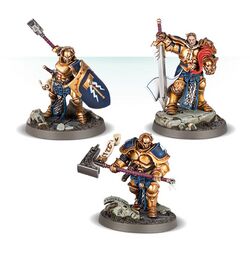
The first Stormcast Eternal Warband and tied for the smallest group currently in the game with the other Stormcast Warbands. Liberator-Prime Steelheart and his two roadtrip buds went to Shadespire to find a cure to the increasing hollowness that plagues Stormcasts when they get reforged, and they're not even gonna try to get out of the city before they have it!
The melee-oriented Stormcast Warband is among the tougher and slower Warbands, and all their attacks hits fairly easily and hits like a bullet train. Their Inspire comes into play when they successfully roll a Shield or Critical on defense, which causes them to gain Nurgle-like toughness and additional attacks... But you'll need to strike a precarious balance because before that, even your four Wound won't save you from attacks; and with only three models, each casualty will severely hurt your board presence and ability to gain Glory Points. Another issue is that Steelheart McLanternjaw, the leader of the Warband, ironically is the least useful model, with no specific role to fill in.
The SC cards are pretty simple - Not bad, just simple. Your opponent will often know what your decks are about the moment you place just one set of gold-plated buttcheeks on the board, but that might necessarily be that much of an issue. It just means that the Champions are a very steady Warband that can take a beating and still work towards their goals.
They are tough, but slow, and warbands like the Orruks, Orcs, Orkz, DA BOYZ with access to a lot of cleave can cause a lot of trouble.
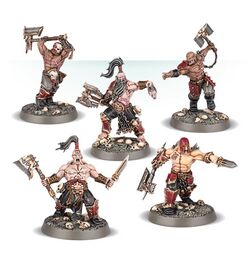
Garrek's Reavers
No Stormcasts without the cannibals in red! They don’t even say why they’re there; maybe Bloodbound just appear spontanously where Stormbois go, like a really sick sort of intestinal disease that usually follows a McDonalds menu? The Reavers is widely considered one of, if not the most difficult Warband to pilot currently in the game... But when they get rolling, they get fucking *rolling*!
The Reavers have five models, varying from pretty okay to absolutely awful. They’re all pretty fast and get faster yet when Inspired, and has a model for every situation - the issue is, they fall like flies to even the slightest attack, with two of the Reavers literally having 2 Wounds and 1 Dodge (which is the worst defense in the game), and the others are only marginally better. However, this is also the Reavers’ trump card, because when any three models in the game are taken Out of Action, *all* Reavers become Inspired, which turns them into some of the most dangerous models in the game! Saek and Garrek himself gets particularly nasty, with very powerful attacks and high movement. When this is combined with the frankly fantastic Reaver Upgrades and Ploys, this Warband goes from weedy to scary in no time. There's a mixed bag included Axe-Chain-Man with the power of axes on a chain allowing ranged melee attacks and Stabbins McGee who can make lots of attacks. By having 5 Speedy Khornezales grabbing objectives is easy, but they drop like flies.
Reaver Decks
- Aggro Reavers: How a warband of Khorne-worshipping mortals who come back to life should play - Fast and hard! Aggro Reavers aims to start the game by attempting to kill as many enemy models as possible before Arnulf and Targor eventually dies by a stiff breeze, which should allow you to become Inspired. Then you pile on the upgrades on Saek, Garrek and Karsus and go to town. These builds are meant to burn like crazy, with loads of easy-to-use reactionary Ploys and great Upgrades that allow your golden boys to reave havoc; most games you'll end with an empty Power Deck! This is not an easy deck to run however, as it requires you to weigh the sacrifices you are going to have to make to be Inspired - if you're not careful, you'll just bloody yourself, like punching yourself in the nose.
- Karsus Unleashed: A variant of the Aggro Reavers that puts most of their Upgrades on Karsus. He's got a Range 2 attack as well as an "attack-everything-within-Range-1" attack, both which benefit massively by Upgrades like Great Strength (+1 Damage to all attacks). Place him somewhere were he gets support from the other models and let him go to town from a safe distance.
- Objective Reavers: Believe it or not, Khorne cultists play a fairly strong Objective game. The Reavers are fast and have quite a few models with allows you to cove most of the board quickly. With the addition of the Move buff from Inspired and Ploys like Sidestep (Move a friendly model one Hex) or Sprint (Next Move is doubled), the Khorne guys are among the fastest Warbands in the game. Only issue is that they aren't very tough compared to other Objective decks, so more bashy Warbands can ruin your day by throwing your bare-torsoed-ass around.
Ironskull's Boyz
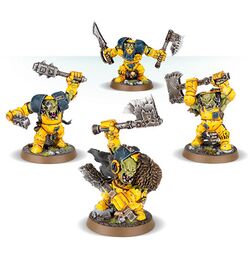
WAAAAAAAAAAAAAGGGGGGHHHH!!!! The 'Ardboyz representing green power. These guys have been stuck in the city for a while(decades) after a looting spree gone wrong. At first the leader, Gurzag Ironskull, did not like it one bit but after the years has grown rather fond of the place. What with an endless cycle of battle and bloodshed, this place is actually rather nice for an Orruk.
These guys are one of the simpler teams to play and is great for beginners. They are tough as hell, have alright movement and hard hitting power from 2 of the 4 members. They inspire simply by taking damage which is rather easy as only a few combos can one-shot these monsters of melee (EDIT: Obviously this was before the COMPLETELY UNEXPECTED power creep in the last expansion block. Now they can die on turn 1. Not that they really care.). Most of their unique Ploys are made to essentially break the game; making extra moves and attacks, making moves after attacking or attacking after moves and so on and so forth. Combining these Ploys in one Activation can cause you to play an entire Turn in a single Activation, clutching a win from defeat at lightning speed! Almost all their objectives focus on them hitting enemies, so don't include all of them in one deck. The orcs aren't suited for Objective play either; they just don't have the movement to claim a lot of Objectives in time.
Their main weakness is Hakka and Basha, whose damage sucks up to several colors of chode, even after they're Inspired. However, with some clever use of Upgrades they can get alright. They are also very predictable to play against, predictable in their unpredictability in a sense. While their Ploys can mess up the game, that's what they have to play with mostly. This isn't that bad though; you've still got 17 Wounds with good Defense, so whatever the enemy can throw at you, you can probably take it in stride.
Orruk Decks
- Grind-Out Orruks: With four tough-as-nails boyz that actually like to take damage, you've got no reason not to throw them into the fire and let them roast. The main difference between you and most Warbands is that you can take it; they usually can't! This deck-type needs a keen eye for opportunities and openings to exploit, as well as a tactican's mind to utilize your Ploys and Upgrades well. For example, don't burn Power Cards on a dude who's probably gonna die soon, and never think that even Basha or Hakka can't do their share; even a single Wound of Damage can make a great difference. This deck uses Brutal but Kunnin' (Make a Move after an Attack), Kunnin' but Brutal (Take a guess), 'Avin' A Good Time (50/50 chance of making an extra attack) to squeeze the most value out of each dude, as well as upgrades like Daemonic Weapon (Dude gets a nasty-ass attack) and 'Ard Head (Hakka or Basha takes a permanent -1 Damage) to boost Basha and Hakka to true killyness.
- "You On Da List?": Also called Board Orcs or Bouncer Orcs, this is a deck based on three Objective Cards that can give fucking 8 Glory Points by the end of the game, with the same requirements basically! These three are Denial (Enemy models didn't end on your board), Contained (Enemy models ended in their Board entirely) and Conquerors (All your models ended in the enemy board), which, as you can imagine, can win you almost any game immediately. Here's the issue - Almost all players who've lost to this before will do everything they can to stop you, Sprinting to the end of your board side to ruin your life. This is why you'll want to make like Blood Bowl and wall the fuck up at the No-Mans Land between the boards, hopefully stopping any intruders. Your deck should also be filled up by defensive and supportive Ploys and Upgrades like Great Toughness (+1 Wound), Unkillable (When Gurzag is killed, 50/50 chance he lives), Healing Potion (Heal 1 or 2 Wounds) and 'Ard Head (Hakka or Basha takes -1 Wounds) to increase your staying power. Note that most of the Nightvault Warbands have a hard counter for this: the Thorns of the Briar Queen can pass right through you, the Eyes of the Nine can summon their Horror into your starting hexes, and Zarbag's Gitz can make mass moves on top of the fact there's twice as many of them as there are of you.
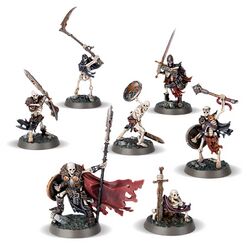
Sepulchral Guard
The remains of several of Shadespire's unfortunate inhabitants, now turned to the service of Nagash in the hopes that he will forgive their insolence (and put them out of their misery). Their boss was once the last Lord Marshal of Shadespire.
Skellington Skwad weighs in with no less fewer actually it is less than 7 dead guys. There's Spear McGiblets the leader who, despite the cool models armor and spear, needs to hide like a bitch boss at the back because only he can resurrect your dead undead. Did we mention that re-animating a two skellymans makes him Inspired? Put simply if you play this band you will activate Boss Skellington most of the 12 actions, and striking the right balance between moving your squishy guys forward to let them get krumped, bringing them back in their more powerful form and actually activating them to have them do shit will win or lose you the game.
There's 2 hero guys, basically skeleton warriors - a mace dude (The Prince) and the sword dude (The Champ) - these guys can actually get shit done and benefit from the better upgrades. They can be resurrected by Spear McGiblets which as is normal (for animated necromantic skeletons) Inspires them. Then there's the remains of Farmer Maggot with his kick ass scythe. This can hit all adjacent foes giving you some area of attack. Finally there's 3 petitioners which at the moment are the worst models in the game - move 2, piss poor attacks. In fact most of your dudes attacks and defence are rubbish, however the upgrades let you take extra attacks or let you get support on actions even if you don't have the models in the right place.
By having 7 models combined with McGiblets' ability to move 2 other skeletons allows you to zerg your opponent and capture objectives. Just be aware that the skeletons are pretty squishy and most warbands won't have much trouble smashing through them - just as well they get back up! Building your deck with the right mix of upgrades and reactions and knowing when to play what to get the most mileage out of your bonebags isn't easy but is really satisfying when it does work.
The Chosen Axes
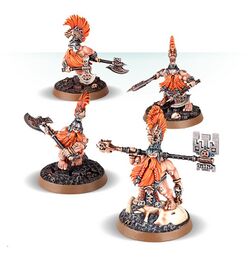
Dwarfs Fyreslayers - expect 4 short, choppy bastards mixed with fire as well as typical stunty grumbling about painting orange. The Fyreslayers of the Vostarg lodge failed an oath of theirs to keep the city safe, and even after hundreds of their number have fallen trying to dispel its curse they're much too stubborn to know when they're beat.
Fyreslayers are supposed to be similar to the Stormcast Eternals but with the ability to specialise in either offense or defense. They are very slow but get inspired from holding objectives. Oddly enough, the massive axe does not count as a ranged weapon, and can only reach one hex...
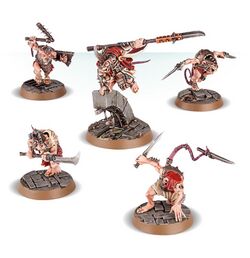
Spiteclaw's Swarm
Skaven - a mini-swarm of 5 ratbois here for the looting. Expect speed and trickyness but to die easier than the skellybones. There'll be ranged attacks and bonuses for outnumbering or supporting against single models.
They get inspired whenever a ploy is used on them. They have two named characters, while the remaining three are more expendable. If they die, one of the three can automatically be brought back a turn (and a ploy allows for another to come back as well in that same turn.)
The Farstriders
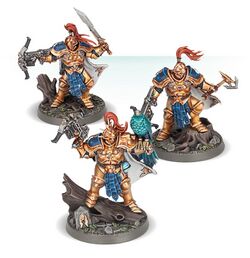
Another band of 3 Stormcast Eternal, with a greater focus on ranged combat. All three of them have their trusty sidearm to plink at the opponent with impunity.They're not as completely OP as they sound, though: plinking does little damage unless boosted by gear/ploys and for them Inspiration only strikes when they end an action phase in enemy territory. Their cards generally either encourage more aggressive play of going forward, bring the fight to the enemy and treat shooting as a bonus; or hang back and pewpew like little bitches with empowered shots but woe if the enemy manages to close the gap. Middle ground is hard to pull off with the limited amount of both minis and cards.
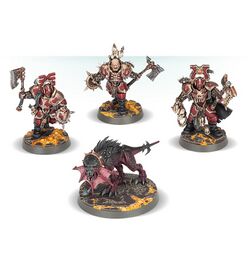
Magore's Fiends
The Stormcast version of the Reavers - choppy and armoured. Four strong; three Fantasy Khorne Berzerker equivalents (the boss Magore and his two pals Ghartok and Zharkus) and Riptooth (aka Doge), a Flesh Hound. They start out rather slow, but become inspired whenever they make a succesful attack which boosts both their speed and their damage. Magore is pretty much a powerhouse once inspired (3 base damage that can be boosted to 4 or 5, he can take an Orruk out in one single blow), Riptooth is faster and more vulnerable than the others but can be surprisingly vicious, and both Ghartok and Zharkus can punch back whoever fail to hit them as a reaction for free.
Fiends Decks
A very aggressive warband, There are 3 broad ways on how to build their deck:
- Blood for The Blood God! - Overused battlecry aside, this version focuses on killing as much as you can, boosting Ghartok and Zharkus and letting them go to town on anything coming nearby with Magore and Doge in support. Basic, straightforward and absolutely unsubtle: Kill them all, Khorne will know his own!
- Skulls for the Skull Throne! - This variant focuses less on pure slaughter but rather on boosting Magore and having him claim the enemy leader's skull for mucho glory points, while the three others keep the rest away. Slightly harder to pilot than just all-out aggro.
- Sic 'em! - This one includes upgrades for Riptooth and tries to take as much advantage as possible of his mobility and the fact he can drag opponents around after chomping on them. Hardest to pull off, but having Doge drag one of your opponent's minis away from the objective he needs to win in extremis or in range of your other madmen is just hilarious.
Nightvault Block
Thorns of the Briar Queen
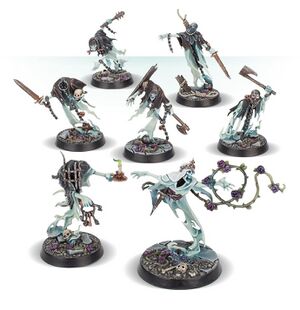
A once-great death mage, the Briar Queen was condemned to an eternity of imprisonment in the depths of the Nightvault when she failed to conquer Shadespire for herself. Nagash, being the asshole that he is, found it most amusing to unleash a former enemy of the Mirrored City against the interlopers trying to claim its secrets. According to the Nighthaunt codex, Nagash actually lets her out of the city on missions, and she mainly stays in Shadespire despite being able to leave due to her grudge against the city.
Like their fellow undead, this Nighthaunt warband consists of 7 spooky ghosts. All of them have the unique ability to treat lethal hexes as normal hexes and can move right through blocked or occupied hexes as well. The Briar Queen herself is a level 2 wizard, and with four wounds and 2 dodge she can take a beating. Varclav the Chained comes with the ability to push all the generic Chainrasps (plus the other guy who's basically a slightly stronger Chainrasp) up to two spaces, and conveniently enough they get inspired any time they're next to an enemy.
They favor an aggressive playstyle blending both objective play and eliminating enemies thanks to their mobility boosts and method of inspiration, and while the individual Chainrasps are somewhat weak they're good at dogpiling enemy fighters since they can slip right past anything in their way- the whole premise of the Bouncer Orcs deck falls apart against them even before their ploys, spells, and upgrades come into play. Using Varclav's ability is a must- he should be close enough to the front lines to push the little ghosts forward while smacking any targets of opportunity, but not so close that he becomes a prime target himself. Any cards with a pushing effect (e.g. Earthquake or your own Howling Vortex spell) will also help you close in on the foe for an easy inspiration. As for ploys, you've got a mix of debuffs like Maddening Cackle (which de-inspires fighters and keeps them from becoming inspired again), buffs like Spectral Chains and Endless Malice, and a few other pushing effects.
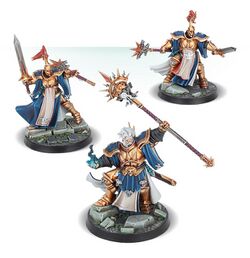
Stormsire's Cursebreakers
Knight-Incantor Averon Stormsire was chosen personally by Sigmar to investigate the curse of Shadespire in the hopes of breaking it, for the irascible mage’s knowledge of unbinding and banishment is extraordinarily comprehensive. Stormsire has long studied the negative effects of the reforging process, and his grim demeanour has only grown more intense as the troubling implications become clearer.
Another trio of Stormcasts, this time from the Sacrosanct Chamber and consequently full of magic. They become inspired by successfully casting spells, which is a good thing because they have a lot of spells. Stormsire himself comes with a ranged magic attack by default, while the other two come with a self-buff spell that allows them to re-roll failed attacks.
Their deck is primarily offensive, and focuses on both upgrade that increase the power of the Cursebreakers and spells for shitting out lightning everywhere. With only three models, Empathic Conduction's healing will be a game-saver, and if you want to zap enemies left and right Cry of Thunder and Chain Lightning are both solid multi-target attack spells.
Eyes of the Nine
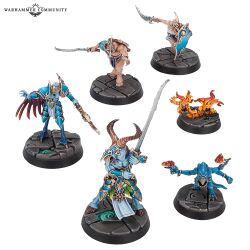
A goodie-bag of Tzeentch: a leading Magister, two Kairic Acolytes, a Blue Horror, and a Tzaangor. They get inspired by successfully performing ranged attacks (with the exception of Tzaangor K'Charik,who is inspired when someone next to him casts a spell, and the Horrors, who don't get inspired at all.) The Magister Vortemis the All-Seeing is rather squishy with only 4 wounds and 1 dodge, but his ranged attack power is high and he can summon a Blue Horror on any starting hex that splits into a Brimstone Horror pair when it dies. (Yes, this includes the enemy's starting hexes too.) As an added bonus, the Horror can be re-summoned any time it's been slain with all of its upgrades intact, making it a constant threat as long as Vortemis is around to bring it back. The Tzaangor is a pretty standard beatstick, and one of the Acolytes has Cleave to deal with tougher targets.
The Eyes of the Nine's deck is strongly control-oriented to take advantage of their good speed and summonable Horror, with plenty of cards that shift the positions of fighters around. And what kind of Tzeentch-themed army would they be if they didn't supplement that with hard-hitting spells?
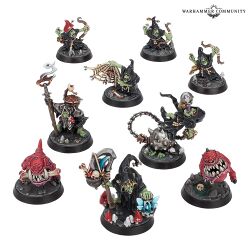
Zarbag's Gitz
The largest warband yet, with NINE FIGS! Seven grots and two squigs! While they're about as resilient as you would expect a grot to be (read: not very), all of them but the Squigs have a special rule that lets them move as a reaction if an ally started a move next to them. With the right positioning and a bit of forethought, the entire warband can be moved with only one activation!
Most of Zarbag's Gitz become inspired after they score at least 3 Glory Points, with the exceptions being the Squigs and Snirk Sourtongue.
Zarbag is squishy for a leader, but he's still a Wizard and hits fairly hard when Inspired. Snirk Sourtongue is a bit of an oddball compared to most fighters- he becomes inspired after any activation(foe or friend alike). When inspired, Snirk gives up the ability to perform all normal actions, but can zoom across the board while pushing and damaging anyone in between him and his target location. The Squig Herder is tankier than the rest of the Grots, and since the Squigs are inspired as soon as he dies your opponent can be forced into a position where killing him can actually be more troublesome than letting him live. The rest of them...well,they're Grots. One has a net and can debuff enemies, but apart from that they're unimpressive.
Zarbag's deck needs to get glory points quickly in order to build up their momentum, but their sheer numbers work in their favor when the Inspiration kicks in and the support bonuses are almost a certainty. Their Ploys help shore up the low offensive power of their individual fighters.
Mollog's Mob

A Bat Squig, a Spiteshroom, a Stalagsquig (think a Squig crossed with a stalagmite), and Mollog himself make up this warband. All Mollog the Dankhold Troggoth wanted was to nap in peace, but the other warbands keep waking him up. Needless to say, he's really cranky now and if they won't keep it down he'll make them keep it down.
Obviously Mollog himself is the centerpiece of the warband; he's a 7-wound monster that can charge with a move token, hits like a truck, and hits every fighter next to him at once. And when he's inspired by taking at least 3 wounds, he can charge if he has a charge token too (but not both a move and a charge token at the same time or if he has two of one token type). While the Squigs can't be given attack upgrades or even hold objectives, they still play a role in distracting and harassing anyone who might try to whittle down Mollog's health. The Bat Squig can move through occupied hexes and treats lethal ones as normal hexes, the Stalagsquig can't move but isn't set up until the first activation of the first round and can be placed on any empty hex including objectives, and the Spiteshroom hits all adjacent fighters at once like Mollog and inflicts damage to everyone near it when it dies.
If you haven't figured it out yet, this warband's success hinges almost entirely on Mollog's survival, so it's a good thing its deck has a fair number of ploys that mitigate his vulnerability to being outranged or outnumbered. The squigs also get some good benefits out of ploys as well, such as being able to respawn a Stalagsquig after it's been beaten or allowing said Stalagsquig to hold objectives.
Godsworn Hunt

Chaos is really working overtime, this time with Darkoath barbarians.
The Godsworn Hunt acts somewhat like a combination of the earlier Chaos warbands- they've got a wizard and ranged attacks like the Eyes of the Nine, the strength in numbers of Garrek's Reavers, and the offensive clout of Magore's Fiends. While not quite as durable or hard-hitting as the Khornate warbands and lacking in the magical potential of the Eyes, their versatility lets them adopt a variety of strategies. Godsworn Hunt fighters become Inspired after receiving an upgrade, which makes them tricky to use early on but allows them to snowball rapidly once the glory points start coming in.
The leader Theddra Skull-Scryer is a level 1 wizard best suited for casting spells from a distance, while heavy hitter Grundann Blood-Eye is somewhat frail but fast enough to keep his distance before going in for the kill. Shond Head-Claimer also acts as a brawler, and he gains Cleave when Inspired. Jagathra carries a javelin, which she can only use once per game but deals a lot of damage when she does so, and archer Ollo has good movement to extend his threat range. Finally, Grawl the hunting dog is quick and good at supporting allies and blocking enemies.
The Godsworn Hunt has a special mechanic in their objectives called Oaths- they work like normal objectives, but award one extra glory point by revealing them to the opponent in the previous action phase. They can help get you enough points to gain an upgrade (and get someone Inspired by doing so), but on the other hand the opponent will now know how to block you from scoring as well.
Due to their role in the deck, Godsworn Hunt players will want to have a lot of upgrades available and spread them around to everyone. Fortunately, their Ploys help in acquiring upgrades and make the upgrades themselves more effective.
Chaos Gargant
Not technically an official warband, a Chaos gargant was added via a free card that came in the white dwarf. Driven mad by the city's shifting shenanigans, the gargant rampages through Shadespire. He is meant to be taken down by both players, and the amount of health he has depends on the number of players he faces. When he loses enough wounds, he gets inspired.
Ylthari's Guardians
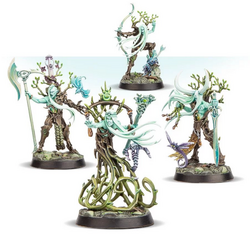
The Necroquake woke up this warband of Sylvaneth, and like Mollog they aren't too thrilled about being interrupted from their magic slumber. They become Inspired by any effect that would heal them, regardless of whether it actually removes wound tokens.
Another all-around warband with a solid blend of melee and ranged options. Ylthari is a flexible mage that can sometimes heal herself after casting spells (and conveniently Inspiring her, boosting her movement to 5). Anhslaine the archer comes with a reaction that allows a bonus attack after defeating an enemy, making her useful for thinning hordes like Zarbag's Gitz. Gallanghann is a melee tank with 4 wounds and 2 block, and Skhathael hits hard and gets Cleave when Inspired.
As you'd expect from their Inspiration condition, their deck comes with a ton of options to restore your warband's health; even some of their objectives trigger only after healing a certain amount. Of course, being healed usually means you have to take damage first and it's still possible to get hurt more than you can heal from.
Thundrik's Profiteers
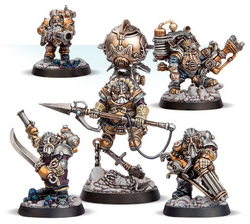
The Katophranes left behind many valuable artifacts, and the Kharadron Overlords are here to find them.
The linchpin of the Warband is Thundrik himself. He's a reliable ranged fighter, and he can put some distance between him and his foes by temporarily converting hexes next to him into lethal hexes. More importantly, he can Inspire a fighter of your choice each time you score an objective, which makes keeping him alive a high priority. Dead-eye Lund is a strong ranged fighter with Cleave, and the knockback on Enrik Ironhail's gun can make sure that anyone not killed by his 3 attacks can't trap him in melee. Khazgan is a flying melee fighter with a backup ranged attack, and Garodd is...just average, pretty much.
Their decks are best served by "score this immediately" objectives to ensure quick inspiring, and have a bunch of ploys and upgrades that focus on damage output.
Beastgrave Block
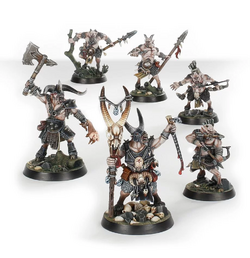
Grashrak's Despoilers
Beastmen warband, consisting of a Bestigor and four Ungors lead by a Bray Shaman. They have come to revel in the unending carnage that Beastgrave grants.
One of the starter warbands for round 3, this warband has a pretty decent mixing of objective, killing, and territory based objectives with a few odds and ends, so you could play them a lot of different ways. The Shaman starts off with a one use token that lets any fighter reroll one dice in an attack action, only getting it refilled when an enemy fighter dies. This factors in to their inspire mechanics, as the entire warband inspires when two enemy fighters are out of action. This can be rather difficult if your up against any warband with less than four fighters, especially any of the stormcast, with a person who knows what they are doing. If you don't know what warband you will be fighting, it might be better to build more on objectives than killing fighters.
Skaeth's Wild Hunt
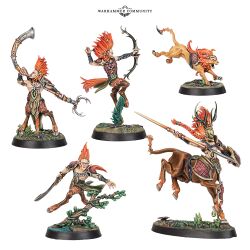
A warband consisting of Kurnothi, a new race that's essentially a combination of Wood Elves and satyrs/centaurs. Skaeth's warband has come in hopes of finding the Beastgrave's heart so it can be killed once and for all.
The other starting warband for round 3, and like the first they have a nice mix of options for objective cards, making a lot of possible play styles. And this is one of the fastest warbands, with every fighter having at least 4 at the start, 2 having 5, and the rest go up to 5 after inspiring. They gain that at the end phase if they have a charge token, they do not inspire right after charging. Each fighter can gain something different from inspiring, so don't just go charging whilly nilly and make it easy to pick your fighters off since they're not all that tough until they inspire. As a nice bonus,they have a wizard who is NOT their warband leader which forces a new kind of tension on the opponent - shall I kill the leader, or the spellcaster?
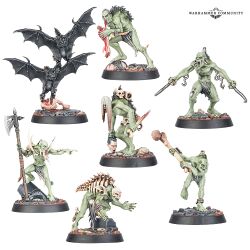
The Grymwatch
Leaked Flesh-Eater Courts warband. Includes the first female Ghoul, in case anybody wanted some mental scarring.
Fluffwise they are knight souls trapped in ghoul body. Crusading in their minds, eating dead meat in reality. Each phase if your leader is on board you may return one of the shitty gohuls back in the game in a semi-random using de dispersion hex.
Ironsoul’s Condemnors
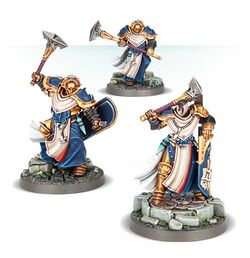
One of the warbands for the "Dreadfane" starter set. Now released outside USA in the Chamions of Dreadfane box set. Mirroring their liberator companions, Ironsoul's condemnors hare a 3 model warband with "the Leader", "the shield", and "the heavy". Ironsoul's condemnors' twist from steelheart's champions is that they have knockback EVERYWHERE. Things are gonna go flying. Their inspire condition requiring a critical hit seems doable, but not having any control on the inspiration timing is pretty spooky, and the inspiration gives some pretty nice perks. With some strong unique warband cards, only melee attacks, and no magic, they are pretty straightforward. Bring in lethal hexes and you will probably be able to send your opponents flying into deathtraps from across the board! Also one of its fighters, when inspired, gets an area attack with cleave and 2 damage rolling 2 dice on hammers, what a beast!
Lady Harrow’s Mournflight
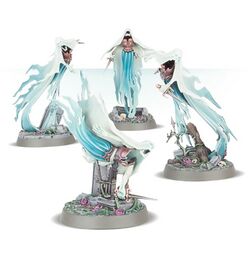
One of the warbands for the "Dreadfane" starter set. Now released outside USA in the Chamions of Dreadfane box set. Lady Harrow's Mournflight is a 4 model warband, but they are the exact same as the easy to build banshees set. Each model has a variety of statlines and inspiration bonus, but all the models look pretty similar, so good luck memorizing who gets what. They did get the same ability as their smaller less choppy counterparts, and their inspiration mechanic is moving through an enemy. With solid stat lines across the board and a very reliable inspire mechanic, these girls lend themselves to being reliable and deadly. With decent wound counts, high movement, and powerful unique warband cards, these girls probably got the better end of the stick in the dreadfane box set. Eventhough Lady Harrow's team can hit hard, they also got some strong objective-focused cards as well.
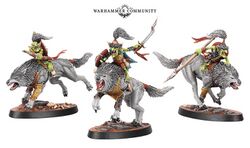
Rippa's Snarlfangs
Despite the Gitmob being squatted, we still got a trio of new wolf rider models!
Rippa Narkbad is an exiled Grot from a tribe of wolf riding Grots who is convinced that one of Gorkamorka’s legendary axes is hidden within Beastgrave. He’s accompanied by his two closest mates and they all ride on venomous wolves called Snarlfangs. Their warband is very fast and with the extra attacks of the wolves, can chew pretty quickly through every kind of enemy, specially horde warbands as the wolf doesn't have to target the same enemy that the gobbo. It must be noted that the wolves attacks are very random, so you'll be having tons of FUN* all the match. It plays as one of the most aggressive warbands, having incredible mobility (5 when inspired) and a high number of attacks that let you do tons of damage.
Hrothgorn's Mantrappers
A big and hungry ogre, but may this not fool you, it's actually a 5 man warband plus a trap.
The Wurmspat
A Nurgle sorceress accompanied by two Putrid Blightkings and a Retchling.